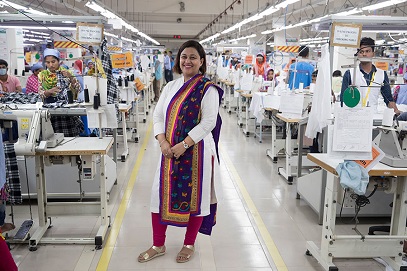As the largest importer of consumer goods in New Zealand, sourcing is at the heart of what we do. You may have heard about the work we’re doing in the ethical or sustainable sourcing areas, but we wanted to provide a refresher on the topics and give you a heads up on what’s coming down the line.
Ethical Sourcing
At The Warehouse Group, we recognise that we have a responsibility to protect the welfare of workers and environmental standards in our supply chain, which is where our ethical sourcing practices come into play. We spoke with Trevor Johnston, Head of Ethical Sourcing to get a better idea of what ethical sourcing is from his point of view.
How would you describe ethical sourcing in its simplest terms?
Ethical sourcing is all about ensuring that our products are being purchased in a responsible way. It’s about making sure that the people who are actually making our products are treated fairly. The Warehouse is committed to operating responsibly – not only in New Zealand but in our offshore supply chain as well. Learn more about our policy.

What standards does The Group have for its factories?
Our Ethical Sourcing Policy describes the worker protections and environmental standards suppliers must have in place in order to join our supply chain. For example through our programme, we verify that the following measures are in place:
- Legal contracts for all workers
- No child or bonded labour
- Fair wages
- A Health and safety programme matched to the industry and its hazards
- Responsible treatment of waste and effluent
Our supply chain is complex, with over 900 suppliers in multiple categories, indirectly engaging up to 500,000 production workers in a typical year. Our policy applies to all of our suppliers as do the local laws in the countries they operate in.Thresholds to enter our supply chain are high – last year we declined 42% of applicants. As a company from a small country like New Zealand, to be able to influence change in these countries by setting forth high standards is remarkable.
How do you monitor what happens in the factories abroad while you’re based in New Zealand?
Each of our global offices has team members focused on ensuring our standards are being met. For example, Shanghai has two team members just focused on Ethical Sourcing who are able to visit factories and support our suppliers development and assessment needs. Beyond this we deploy a network of specially trained labour and environment assessors throughout our Asia supply chain.
What programmes do we offer our production workers in the factories?
One initiative that’s kicked off recently that I’m proud of is our involvement with the HER Project in Bangladesh. HER Project is an NGO helping women around the world who are working in factories get training on topics like health, financial inclusion and gender equality. We’re proud to be working with them to ensure some of the most vulnerable workers in our supply chain have access to these tools. We’ll have more to share on how the programme is coming along over the next few months.
More information: Ethical Sourcing Report
Sustainable Sourcing
You can think of sustainable sourcing as the environmental cousin of ethical sourcing. For the sustainable sourcing teams, it’s all about finding ways to benefit our environment and our products through our actions.
Yi You, Project Coordinator for Environmental Initiatives at The Warehouse is heavily involved in the Group’s environmental efforts. Read below as Yi offers us a view into what sustainability at the group is all about.
How would you describe sustainable sourcing in its simplest terms?
Sustainable sourcing is about going beyond economic considerations of a material or product, and taking into account environmental, social and ethical factors as well. It’s about thinking, “Can we feel good about offering this product to our customers?” We want to help our customers live more sustainably by giving them peace of mind that the products they are buying have been sourced in an environmentally sustainable manner.
To achieve this, we set an overarching policy for the Group as a whole that offers guidelines on materials and products for each of our brands.
What is a main focus for the Group sustainability-wise?
Moving forward, packaging is one of our key areas of focus. Given that we ship about 3.5 million boxes per year to our customers, it’s important that we have more sustainable packaging choices.
Because of the urgency surrounding the reduction of plastic packaging we’ve been hearing from the community, a strategic focus for The Group is on improving disuse of plastic. We want to strike the balance between having products and packaging that use less plastic but are still well-protected to ensure our customers receive undamaged goods.
We have an initiative focusing on using only reusable, compostable or recyclable plastic in all our house brand product packaging by 2025 or sooner. This requires that we map all of our product categories and understand the baseline amount of materials we’re using that do not comply with those three categories. From there, we’ll work with our manufacturers to ensure that any future products and packaging we create are compliant.
It’s a timely focus as more organisations and government agencies are making bold moves to reduce plastic usage. The Government recently announced a plan to improve kerbside and commercial recycling, reduce contamination of recyclables and increase onshore processing of plastics and other materials. Associate Minister for the Environment Eugenie Sage says that these plans are necessary “…to help New Zealand shift to a circular economy approach where products are better designed so that more materials can be recovered and re-used.”
What initiatives does the team have planned for the future?
As we’ve recently announced, we’re committed to transitioning 30% of our light fleet vehicles to EV by the end of 2019. This means 71 vehicles, which account for 360 tonnes of carbon emissions each year, will be replaced. Read more about our EV transition.
Waste minimisation is another big goal for The Group. We’d like to increase the recycling percentage of our operational waste to 85%, cutting back on wasteful plastic packaging and encouraging our manufacturers to do the same.
In 11 of our Auckland The Warehouse stores, we’re once again offering soft plastic recycling bins for consumers. These recycled items will be turned into items including garden edging and fence posts, which is a great example of the circular economy in action.
Ultimately, much of the work we do is about not only educating ourselves and sourcing the best materials but educating our consumers and helping them make better choices when it comes to sustainability.




